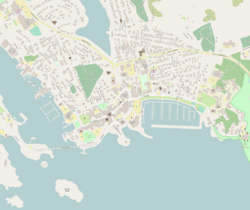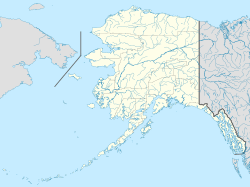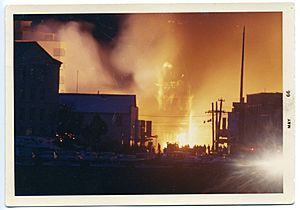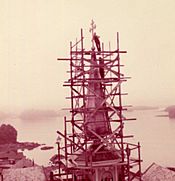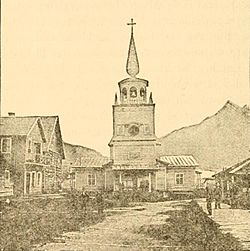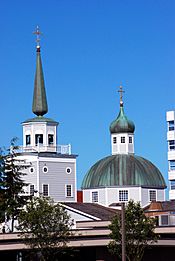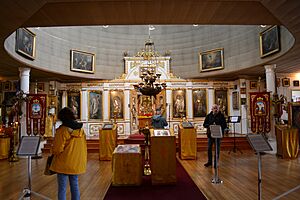St. Michael's Cathedral (Sitka, Alaska) facts for kids
|
St. Michael's Cathedral
|
|
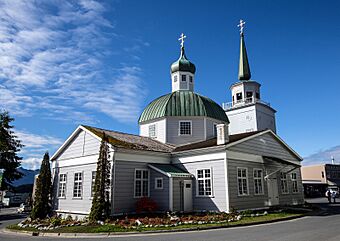
Saint Michael's Cathedral.
|
|
| Location | 240 Lincoln Street, Sitka, Alaska |
|---|---|
| Area | 0.16 acres (0.065 ha) |
| Built | 1848 |
| Architect | Bishop Innocent (Veniaminov); Sergey Padyukov |
| Architectural style | Russian |
| MPS | Russian Orthodox Church Buildings and Sites TR (AD) |
| NRHP reference No. | 66000165 |
Quick facts for kids Significant dates |
|
| Added to NRHP | October 15, 1966 |
| Designated NHL | June 13, 1962 |
St. Michael's Cathedral (Russian: Собор Архангела Михаила Sobor Arkhangela Mikhaila) is a famous church in Sitka, Alaska. It is also known as the Cathedral of St. Michael the Archangel. This church is part of the Orthodox Church in America Diocese of Alaska. It stands at Lincoln and Maksoutoff Streets in Sitka.
This cathedral was the first Orthodox church built in the New World. It was constructed in the 1800s when Alaska was controlled by Russia. The original building was destroyed by fire in 1966. However, it was rebuilt later.
Since 1962, St. Michael's Cathedral has been a National Historic Landmark. This means it is a very important place in history. It shows the strong influence Russia had in North America, especially in Southeast Alaska. The new building has green domes and golden crosses. These features make it a well-known sight in Sitka. Some of the icons inside the church are very old, dating back to the mid-1600s. Two of these icons were painted by Vladimir Borovikovsky.
The cathedral is in downtown Sitka, on the coast of Baranof Island. The streets around it, Lincoln Street and Maksoutoff Street, look much like they did over 100 years ago. The restored Russian Bishop's House is also nearby. This house was once home to the first Orthodox Bishop of Alaska, Innocent (Veniaminov). The National Park Service now manages it as part of the Sitka National Historical Park.
Contents
History of the Cathedral
A small chapel was first built in Sitka by an employee of Alexander Andreyevich Baranov. Baranov was the main manager of the Russian-American Company. This chapel was ready in time to receive special religious pictures, called icons. These icons were saved from a shipwreck in 1813. In 1808, Baranov moved his main office in North America to New Archangel (now Sitka). He chose this spot because it had better defenses.
Baranov asked for a priest and "the finest of church furnishings" for his new base. In 1816, Father Aleksei Sokolov was the first priest to arrive in Sitka from Russia. He brought important icons with him. The old church became worn out and was replaced in 1834. This new building was also dedicated to St. Michael.
Building the First Cathedral
The main cathedral was planned and designed by Father Innocent Veniaminov. He was a priest from Siberia who had worked in Unalaska, Alaska, for ten years. There, he had designed a church with two domes and started a school. He designed St. Michael's Cathedral in a Russian church style. It is known as one of the best examples of this style in North America.
Construction began in 1844, and the cathedral was finished on November 20, 1848. The Russian-American Company paid for the project. The church bells were made in Alaska. Innocent himself made the clock that was placed in the bell tower.
In 1867, Alaska was sold to the United States. After the sale, Army Major General Jefferson C. Davis arrived in Sitka with soldiers. Sadly, some soldiers damaged the cathedral, as well as local businesses and homes.
Protecting the Cathedral's Treasures
A group called the Temperance Society and Brotherhood was formed within the cathedral. This group was very important in taking care of the building. They helped keep it in good condition during the difficult years after Alaska was sold. In 1909, this society made a small model of the cathedral. They showed it at an exhibition in San Francisco.
When Russia ruled Alaska, rich Russian families gave many valuable art pieces to the church. Most of these treasures were saved from the fire in January 1966. They are now displayed in the new cathedral. A special gift was the icon of Our Lady of Kazan, also called the Sitka Madonna. This icon was given by the workers of the Russian-American Company. In 1962, the National Park Service officially named St. Michael's Cathedral a National Historic Landmark.
The Original Cathedral
The first cathedral was built between 1844 and 1848. It stayed in good condition for over 100 years. It had only a few changes until it burned down in January 1966. At that time, it was the oldest church in Alaska. It was built using logs from local trees. The outside walls had clapboard siding. The domes were made of metal, and the roofs were originally wood shingles. Later, the roof shingles were changed to asphalt.
The most valuable items saved from the fire were the royal doors. These doors were in the center of the Ikonostasis. An ikonostasis is a wall of icons and religious paintings that separates the main part of the church from the altar. The beautiful chandelier was also saved and restored. Silk and brocade vestments (special clothes for priests) were also rescued.
However, some important items were lost in the fire. These included the handmade bells and a large icon of the Last Supper. This icon had decorated the top of the royal doors. The clock in the bell tower was also lost. A large library with books in Russian, Tlingit, and Aleut languages was also destroyed.
The Present Cathedral
How the New Cathedral Was Built
The new cathedral was rebuilt based on drawings from 1961. These drawings were made by the Historic American Buildings Survey. This helped make sure the new building was the same size and in the same spot as the old one. However, modern fireproof materials were used for its construction.
The new cathedral was built with concrete and steel. The outside has vinyl siding that looks like the original finish. The roof is covered with asphalt shingles. The domes have copper roofing. The Cathedral of St. Michael was officially opened again in 1978. The old Chapel of St. John the Baptist was renamed in honor of St. Innocent Veniaminov of Alaska.
All the icons and religious items that were saved from the fire were put back in the new cathedral. They were placed in the same order as they were in the original building. The front of the church is shaped like a Greek cross and has a bell tower. Similar churches can be found in St Petersburg, Russia. They were built in the late 1700s and early 1800s. The cathedral has two domes. One is above the main altar area.
Design and Layout
The front of the cathedral is about 67 feet wide, and its length is about 96.6 feet. The outside is painted a light blue-grey with white borders. The western front has the bell tower in the middle. It is about 40 feet tall and shaped like a cupola (a small dome). It has eight arched openings, each with a bell. The dome is shaped like a needle and has a special Orthodox cross with three bars. A railing goes around the cupola.
The top half of the tower has fake windows for decoration. A round clock with Roman numerals is placed between two large fake windows on the north, south, and west sides. A double door in the center leads into the entrance area of the cathedral. This entrance is at the bottom of the bell tower. The main part of the church, called the nave, is to the east of this entrance. The church's cruciform plan (cross shape) is made by the outer walls. These walls extend out to the west of two smaller chapels.
The main dome is shaped like an octagon and has windows on each side. An onion dome is built above the main dome. This decorative onion dome has a three-bar cross at its very top. The back part of the cathedral, called the apse, is at the eastern end. It is the same size as the outer walls of the nave. There are two chapels, both the same size. They are located along the north and south sides of the nave. A double door (which is not used) provides entry to these chapels.
The cathedral has public areas that are well-lit. Natural light comes from the windows in the dome and from two large windows in each chapel. The north and south walls of the nave also have windows for light. Many fake windows are also used as decorations on the outside.
The inside of the church also has a cross shape, just like the original cathedral. The walls and ceiling are covered with rough, natural-colored sail-cloth. This was also how the original cathedral looked. The western part of the nave has a flat ceiling made of sail-cloth. This leads to the open dome in the center of the church, above the Bishop's Throne. The new cathedral has only four columns, instead of eight like the original. These columns are made of steel and concrete and are covered with sail-cloth.
Inside the Cathedral
The inside of the cathedral is decorated with the rich and valuable collection of Russian religious art. These artworks had decorated the first cathedral. Two very important icons, both by Borovikovsky, are Our Lady of Sitka (also known as the "Sitka Madonna") and Christ Pantocrator ("Christ the Judge").
The icon screens, which separate the main part of the church and the chapels from the altars, are hung on the walls. In the center of the main part of the church is a raised platform. This is where the bishop's throne is located. It has a cushioned seat without a back. This throne represents the Diocese. There is also a beautifully embroidered carpet, called an "orlets," used by the bishop during services.
The iconostasis of the main altar, dedicated to the Archangel Michael, has special doors for the deacons and royal doors. These doors are in the Italian Roccoco style. This style is very fancy, which is a contrast to the simple walls inside and out. The screen of the iconostasis itself is new. It is carved from wood and painted white with gold borders. It is an exact copy made from a small piece of the original that was saved from the fire.
The icons of Christ the Savior and the Virgin Mary were made in the 1700s and 1800s. They are covered in silver. The icon of the Archangel Michael is on the far right, and St. Nicholas is on the far left. These are made of silver but are covered in gold. You can also see icons of the Four Evangelists carved on the four corners of the door. Icons of the Annunciation and the Theotokos (Mother of God) are carved in the center. All these icons have been recently restored.
Paintings showing scenes from the Old and New Testaments decorate the walls of the dome and the chapel. These paintings are in the style of Western religious art. They were gifts from Count Viktor Kochubey and Countess Anna Orlova. These people were close to the Russian rulers Alexander I (1800–1825) and Nicholas I (1825–1855).
Besides all the decorations, there are five display cases inside the cathedral. These cases are filled with treasures that were saved from the fire. Two cases are in each chapel, and one is in the main part of the church.
See also
 In Spanish: Catedral de San Miguel de Sitka para niños
In Spanish: Catedral de San Miguel de Sitka para niños


